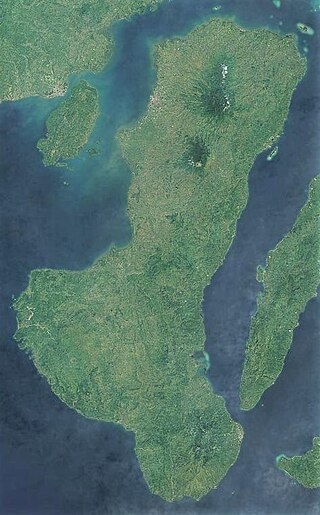
Negros Occidental, officially the Province of Negros Occidental, is a province in the Philippines located in the Negros Island Region. Its capital is the city of Bacolod, of which it is geographically situated and grouped under by the Philippine Statistics Authority, but remains politically independent from the provincial government. It occupies the northwestern half of the large island of Negros, and borders Negros Oriental, which comprises the southeastern half. Known as the "Sugarbowl of the Philippines", Negros Occidental produces more than half the nation's sugar output.

Bacolod, officially the City of Bacolod, is a 1st class highly urbanized city in the Negros Island Region in the Philippines. With a total of 600,783 inhabitants as of the 2020 census, it is the most populous city in the Negros Island Region and the second most populous city in the entire Visayas after Cebu City.

Silay, officially the City of Silay, is a 3rd class component city in the province of Negros Occidental, Philippines. According to the 2020 census, it has a population of 130,478 people.

Talisay, officially the City of Talisay, is a fourth class component city in the province of Negros Occidental, Philippines. According to the 2020 census, it has a population of 108,909 people.

Leandro Valencia Locsin, Sr., also known by the initials LVL and the nickname "Lindy", was a Filipino architect, artist, and interior designer known for his use of concrete, floating volume and simplistic design in his various projects. An avid collector, he was fond of modern painting and Chinese ceramics. He was proclaimed a National Artist of the Philippines for Architecture in 1990 by the late President Corazon C. Aquino.

The University of St. La Salle (USLS) is a Catholic private research university run by the De La Salle Brothers, located in La Salle Avenue, Bacolod, Negros Occidental, Philippines. Established in 1952 as La Salle College - Bacolod, it is the second oldest campus founded by the congregation in the country. The university is a member of De La Salle Philippines, a network established in 2006 comprising 16 Lasallian educational institutions in the Philippine islands. The university offers preschool, elementary, secondary, undergraduate, and graduate programs. It has seven colleges namely: Business and Accountancy, Engineering and Technology, Arts and Sciences, Education, Nursing, Law, and Medicine.

The Negros Revolution, commemorated and popularly known as the Fifth of November or Negros Day, was a political movement that in 1898 created a government on Negros Island in the Philippines, ending Spanish control of the island and paving the way for a republican government run by the Negrense natives. The newly established Negros Republic lasted for approximately three months. American forces landed on the island unopposed on February 2, 1899, ending the island's independence. Negros was then annexed to the Philippine Islands on 20 April 1901.

The Jose B. Lingad Memorial General Hospital is located in San Fernando, Pampanga, Philippines. It is a Level III tertiary, training and teaching hospital with 250 authorized beds as mandated by Republic Act (R.A.) 6780 enacted in 1990. The hospital caters to the people of Region III, with the people of Pampanga as its primary catchment area and the nearby provinces of Bataan, Nueva Ecija, Bulacan, Tarlac, Zambales and Aurora as its secondary catchment areas.

Jose Corteza Locsin was a Filipino medical doctor and senator.

Carlos Hilado Memorial State University, also colloquially called by its former acronym CHMSC, is a public, state-owned university, the main campus of which is in Talisay, Negros Occidental, Philippines. It provides preschool, elementary, secondary, higher technological, professional and vocational instruction and training in science, agriculture and industrial fields, as well as short-term or vocational courses.
Lacson is a Filipino surname with deep historical roots originating in the provinces of Iloilo and Negros Occidental, and with branches extending to Cavite and Pampanga. They are a prominent family involved in business, politics, real estate, and agriculture. The surname "Lacson" is a transliterated Chinese-Filipino surname with historical variations influenced by Spanish orthography. It is derived from the Hokkien "la̍k-sun", and has also been spelled as Laxon and Laczon by the Spaniards.

The John B. Lacson Foundation Maritime University is a private maritime institution based in Molo, Iloilo City, Philippines. It is the first maritime school in the Visayas and Mindanao, first private maritime education and training institution in the Philippines, and the first maritime institution in the country to obtain the accreditation of DNV.
Nepalese people in the Philippines form a small migrant and immigrant community consisting mostly of doctors and medical students with Nepalese origin.

Ancestral houses of the Philippines or Heritage Houses are homes owned and preserved by the same family for several generations as part of the Filipino family culture. It corresponds to long tradition by Filipino people of giving reverence for ancestors and elders. Houses could be a simple house to a mansion. The most common ones are the "Bahay na Bato". Some houses of prominent families had become points of interest or museums in their community because of its cultural, architectural or historical significance. These houses that are deemed of significant importance to the Filipino culture are declared Heritage House by the National Historical Commission of the Philippines (NHCP), previously known as the National Historical Institute (NHI) of the Philippines. Preservation is of utmost importance as some ancestral houses have come into danger due to business people who buy old houses in the provinces, dismantle them then sell the parts as ancestral building materials for homeowners wishing to have the ancestral ambiance on their houses. These ancestral houses provide the current generation a look back of the country's colonial past through these old houses.
Teodoro Montelibano Locsin was a journalist, publisher of The Philippines Free Press Magazine and father of former Secretary of Foreign Affairs Teodoro Locsin Jr.

Negros, is the fourth largest and third most populous island in the Philippines, with a total land area of 13,309 km2 (5,139 sq mi). The coastal zone of the southern part of Negros is identified as a site of highest marine biodiversity importance in the Coral Triangle.

The Eastern Visayas Medical Center (EVMC) is a tertiary level teaching and training government hospital in the Philippines.

Capitol Central, previously called the Negros Occidental Provincial Capitol Complex, is a government complex and mixed-use estate centered around the Negros Occidental Provincial Capitol, currently co-managed with Ayala Land. Certain portions are leased or sold to Ayala Land, as part of their industrial estate in Bacolod, Philippines.

The Negros Island Region (NIR) is an administrative region in the Philippines. Covering both the islands of Negros and Siquijor, the region is composed of three provinces: Negros Occidental, Negros Oriental, and Siquijor, as well as the highly urbanized city of Bacolod. The regional centers are Bacolod and Dumaguete.
The COVID-19 pandemic in Western Visayas is part of the worldwide pandemic of coronavirus disease 2019 caused by severe acute respiratory syndrome coronavirus 2. The virus reached Western Visayas on March 20, 2020, when the first case of the disease was confirmed in Bacolod. All provinces have at least one confirmed COVID-19 case.


















